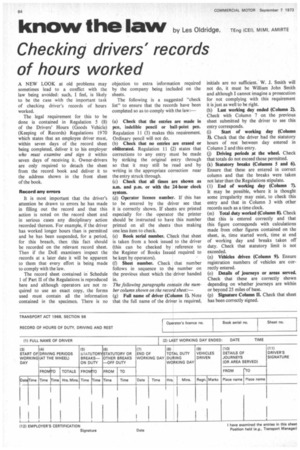k now the law by Les Oldndge, TEng (CEI), MIMI, AMIRTE
Page 86

If you've noticed an error in this article please click here to report it so we can fix it.
Checking drivers' records of hours worked
A NEW LOOK at old problems may sometimes lead to a conflict with the law being avoided: such, I feel, is likely to be the case with the important task of checking driver's records of hours worked.
The legal requirement for this to be done is contained in Regulation 5 (8) of the Drivers' Hours (Goods Vehicle) (Keeping of Records) Regulations 1970 which states that an employee driver must, within seven days of the record sheet being completed, deliver it to his employer who must examine and sign it within seven days of receiving it. Owner-drivers are only required to detach the sheet from the record book and deliver it to the address shown in the front sheet of the book.
Record any errors
It is most important that the driver's attention be drawn to errors he has made in filling out the record and that this action is noted on the record sheet and in serious cases any disciplinary action recorded thereon. For example, if the driver has worked longer hours than is permitted and he has been suspended, for a period, for this breach, then this fact should be recorded on the relevant record sheet. Then if the DoE examiners inspect the records at a later date it will be apparent to them that every effort is being made to comply with the law.
The record sheet contained in Schedule I of Part II of the Regulations is reproduced here and although operators are not required to use an exact copy, the forms used must contain all the information contained in the specimen. There is no objection to extra information required by the company being included on the sheets.
The following is a suggested "check list" to ensure that the records have been completed so as to comply with the law:—
(a) Check that the entries are made in pen, indelible pencil or bail-point pen. Regulation 11 (3) makes this recmirement. Ordinary pencil will not do.
(b) Check that no entries are erased or obliterated. Regulation 11 (2) states that corrections to any entry must be made by striking the original entry through so that it may still be read and by writing in the appropriate correction near the entry struck through.
(c) Check that all times are shown as am. and p.m. or with the 24-hour clock system.
(d) Operator licence number. If this has to be entered by the driver see that it is correctly shown. If sheets are printed especially for the operator the printer should be instructed to have this number printed on all the sheets thus making one less item to check.
(e) Book serial number. Check that sheet is taken from a book issued to the driver (this can be checked by reference to the Register of Books Issued required to be kept by operators).
(f) Sheet number. Check that number follows in sequence to the number on the previOus sheet which the driver handed in.
The following paragraphs contain the number column shown on the record sheet:—
(g) Full name of driver (Column 1). Note that the full name of the driver is required, initials are no sufficient. W. J. Smith will not do, it must be William John Smith and although I cannot imagine a prosecution for not complying with this requirement it is just as well to be right.
(h) Last working day ended (Column 2). Check with Column 7 on the previous sheet submitted by the driver to see this entry corresponds.
(i) Start of working day (Column 3). Check that the driver had the statutory hours of rest between day entered in Column 2 and this entry.
(j) Driving periods at the wheel. Check that totals do not exceed those permitted.
(k) Statutory breaks (Columns 5 and 6). Ensure that these are entered in correct column and that the breaks were taken not later than the Regulations stipulate.
(1) End of working day (Column 7). It may be possible, where it is thought some irregularity may exist, to check this entry and that in Column 3 with other records such as a time clock.
(m) Total duty worked (Column 8). Check that this is entered correctly and that this figure corresponds with calculations made from other figures contained on the sheet, ie, time started work, time at end of working day and breaks taken off duty. Check that statutory limit is not exceeded.
(n) Vehicles driven (Column 9). Ensure registration numbers of vehicles are correctly entered.
(o) Details of journeys or areas served. Check that these are correctly shown depending on whether journeys are within or beyond 25 miles of base.
(p) Signature Column IL Check that sheet has been correctly signed.








































































































































